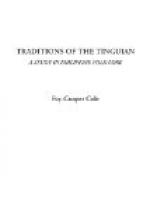[64] See p. 13, note 5.
[65] The Pala-an is third in importance among Tinguian ceremonies.
[66] Tale 58.
[67] This is offered only as a possible explanation, for little is known of the beliefs of this group of Igorot.
[68] See p. 14, note 2.
[69] Tale 68.
[70] Hose and McDougall, The Pagan Tribes of Borneo, Vol. II, p. 148, (London, 1912).
[71] Bezemer, Volksdichtung aus Indonesien, p. 304, Haag, 1904. For the Tagalog version of this tale see Bayliss, (Jour. Am. Folk-lore, Vol. XXI, 1908, p. 46).
[72] Evans, Folk Stories of British North Borneo. (Journal Royal Anthropological Institute, Vol. XLIII, 1913, p. 475).
[73] Folk Stories of British North Borneo (Journal Royal Anthropological Institute, Vol. XLIII, p. 447, 1913).
[74] Tale No. 89.
[75] Hose and McDougall, The Pagan Tribes of Borneo, Vol. II, pp. 144-146.
[76] Tale 91. The cloak which causes invisibility is found in Grimm’s tale of the raven. See Grimm’s Fairy Tales, Columbus Series, p. 30. In a Pampanga tale the possessor of a magic stone becomes invisible when squeezes it. See Bayliss, (Jour. Am. Folk-Lore, Vol. XXI, 1908, p. 48).
[77] Ratzel, History of Mankind, Vol. I, Book II. Graebner, Methode der Ethnologie, Heidelberg, 1911; Die melanesische Bogenkultur und ihre Verwandten (Anthropos, Vol. IV, pp. 726, 998, 1909).
[78] See Waterman, Journal American Folklore, Vol. XXVII, 1914, pp. 45-46.
[79] Stories of magic growth are frequently found in North America. See Kroeber, Gross Ventre Myths and Tales (Anthropological Papers of the Am. Mus. of Nat. Hist., Vol. I, p. 82); also Lowie, The Assiniboin (ibid., Vol. IV, Pt. 1, p. 136).
[80] Other examples of equally widespread tales are noted by Boas, Indianische Sagen, p. 852, (Berlin, 1895); L. Roth, Custom and Myth, pp. 87 ff., (New York, 1885); and others. A discussion of the spread of similar material will be found in Graebner, Methode der Ethnologie, p. 115; Ehrenreich, Mythen und Legenden der suedamerikanischen Urvoelker, pp. 77 ff.; Ehrenreich, Die allgemeine Mythologie und ihre ethnologischen Grundlagen, p. 270.
[81] Cole and Laufer, Chinese Pottery in the Philippines (Publication Field Museum of Natural History, Anthropological Series, Vol. XII, No. 1, Chicago, 1913).
[82] Nieuwenhuis, Kunstperlen und ihre kulturelle Bedeutung (Int. Arch, fuer Ethnographie, Vol. XVI, 1903, pp. 136-154).
[83] Philippine Journal of Science, Vol. III, No. 4, 1908, pp. 197-211.
[84] A vine the new leaves of which are used for greens.
[85] Antidesma ghesaembilla Gaertn.




